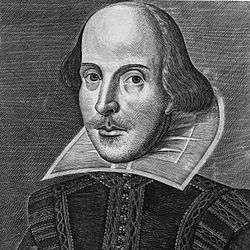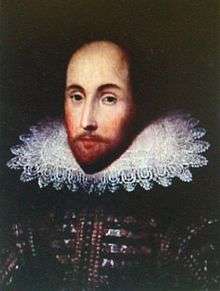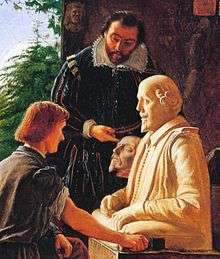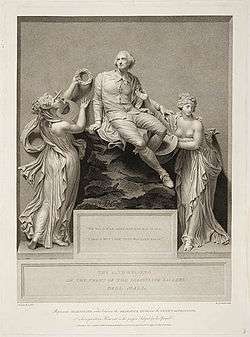Portraits of Shakespeare
Within four decades of its foundation in 1856, upwards of 60 portraits were offered for sale to the National Portrait Gallery purporting to be of William Shakespeare,[1] but there are only two definitively accepted as portraying him, both of which are posthumous. One is the engraving that appears on the cover of the First Folio (1623) and the other is the sculpture that adorns his memorial in Stratford upon Avon, which dates from before 1623. However, several paintings from the period have also been argued to represent him.
There is no concrete evidence that Shakespeare ever commissioned a portrait, and there is no written description of his physical appearance. However, it is thought that portraits of him did circulate during his lifetime because of a reference to one in the anonymous play Return from Parnassus (c. 1601), in which a character says "O sweet Mr Shakespeare! I'll have his picture in my study at the court."[2]
After his death, as Shakespeare's reputation grew, artists created portraits and narrative paintings depicting him, most of which were based on earlier images, but some of which were purely imaginative. He was also increasingly commemorated in Shakespeare memorial sculptures, initially in Britain, and later elsewhere around the world. At the same time, the clamour for authentic portraits fed a market for fakes and misidentifications.
Portraits clearly identified as Shakespeare

There are two representations of Shakespeare that are unambiguously identified as him, although both may be posthumous.
- Droeshout portrait. An engraving by Martin Droeshout as frontispiece to the collected works of Shakespeare (the First Folio), printed in 1622 and published in 1623. An introductory poem in the First Folio, by Ben Jonson, implies that it is a very good likeness.[3]
- The bust in Shakespeare's funerary monument, in the choir of Holy Trinity Church, Stratford-on-Avon. This half-length statue on his memorial must have been erected within six years after Shakespeare’s death in 1616. It is believed to have been commissioned by the poet’s son-in-law, Dr John Hall, and must have been seen by Shakespeare's widow Anne. It is believed that the bust was made by the Flemish artist Gerard Johnson.
Possible portraits
There are several portraits dated to the 17th century that have been claimed to represent Shakespeare, although in each the sitter is either unidentified or the identification with Shakespeare is debatable.
Probably made during Shakespeare's lifetime
- The Chandos portrait. This portrait is attributed to John Taylor, and dated to about 1610. In 2006, the National Portrait Gallery published a report authored by Tarnya Cooper saying it is the only painting with any real claim to have been done from life. The Cobbe portrait had not been discovered at that time, but Cooper has since confirmed her opinion. The name arose as it was once in the possession of the Duke of Chandos.[4]
- The Chess Players attributed to Karel van Mander. This was identified in 1916 as an image of Ben Jonson and Shakespeare playing chess.[5] Most scholars consider this to be pure speculation, but the claim was revived in 2004 by Jeffrey Netto, who argued that the chess game symbolises "the well known professional rivalry between these figures in terms of a battle of wits".[6]
- The Cobbe portrait: In 2009, Stanley Wells and the Shakespeare Birthplace Trust announced that they believe this painting, which has been in the possession of the Cobbe family since the early 18th century, is a portrait of Shakespeare drawn from life. The portrait is thought to have belonged initially to Shakespeare's patron, Henry Wriothesley, 3rd Earl of Southampton, and to have been copied by another artist who created the painting known as the Janssen portrait, which had already been claimed to depict Shakespeare.[7][8][9][10] Tarnya Cooper, the 17th-century art specialist at the National Portrait Gallery, argues that both paintings depict Thomas Overbury.[11]
- The Grafton Portrait by an unknown artist of a man whose age, like Shakespeare's, was 24 in 1588. Otherwise there is no reason to believe it is Shakespeare except for a certain compatibility with the faces of other leading contenders. It belongs to the John Rylands University Library Manchester.[12]
- A Man Clasping a Hand from a Cloud, by Nicholas Hilliard dated 1588. This was identified as Shakespeare by Leslie Hotson in his book Shakespeare by Hilliard (1977). Skeptical scholars believe this is unlikely. Roy Strong suggested that it is Lord Thomas Howard, first Earl of Suffolk. (National Portrait Gallery, London)[13]
- The Sanders Portrait. This has a label attached identifying it as Shakespeare and stating that it was painted in 1603. New scientific tests on the label and the oak panel suggest that it dates to Shakespeare's lifetime,[14] which, if true, would make this a likely authentic image of Shakespeare. It is attributed by a family tradition to one John Sanders, or possibly his brother Thomas,[15] who is believed to have been a scene painter for William Shakespeare's Theatre Company. The identification has been queried on the grounds that the subject appears to be too young for the 39-year-old Shakespeare in 1603 and that 23 April birth date on the label reflects the conventional date adopted in the 18th century, which is not certain to be accurate.[7] The inscription on the label "This likeness taken" has been criticised as not a contemporary formulation.[16]
- The Zuccari portrait. A life-size oval portrait painted on a wooden panel. This was owned by Richard Cosway, who attributed it to Federico Zuccari, an artist who was contemporary with Shakespeare. It is no longer attributed to him, nor is there any evidence to identify it as Shakespeare; however it was probably painted during his lifetime and may depict a poet.[7]
Gallery: portraits claimed to be of Shakespeare painted from life
-

The Chandos portrait
-

The Cobbe portrait
-

The Janssen portrait
-

The Janssen portrait as it appeared before restoration in 1988
-

Nicholas Hilliard: Man Clasping Hand from a Cloud
-

The Grafton portrait
-

The Soest portrait (painted at least 20 years after Shakespeare's death)
-

The Flower portrait (known to be a 19th-century forgery)
-

The Chess Players
-

A print after the Zuccari portrait
-

The Stratford portrait
Probably made within living memory of Shakespeare

In the decades after Shakespeare's death a number of portraits were made based on existing images or living memory. The most important of these are:
- The Soest portrait, probably painted by Gerard Soest. The painting was first described by George Vertue, who attributed it to Peter Lely and stated that it was painted from a man who was said to look like Shakespeare.[7] It was owned by Thomas Wright of Covent Garden in 1725 when it was engraved by John Simon and attributed to Soest. It was probably painted in the late 1660s, after the Restoration permitted the reopening of the London theatres.[7]
- The Chesterfield portrait, dated 1660-1670, possibly painted by the Dutch painter Pieter Borsseler, who worked in England in the second half of the 17th century.[17] Its title derives from the fact that it was owned by the Earl of Chesterfield. It is generally assumed to be based on the Chandos portrait, which is evidence that the Chandos was accepted as a depiction of Shakespeare within living memory of the writer.[7]
- The Marshall portrait. John Benson's 1640 edition of Shakespeare's poems included an engraving of Shakespeare by William Marshall. This is a stylised and reversed version of the Droeshout portrait.
Later works, misidentifications, and fakes
A number of other copies or adaptations of the Chandos and Droeshout images were made in the later 17th century and early 18th century, such as William Faithorne's frontispiece of the 1655 edition of The Rape of Lucrece, and Louis Francois Roubiliac's copy of the Chandos, made as preparation for his sculpture of Shakespeare. These increased in number by the later 18th century and early 19th century, including an adaptation of Droeshout by William Blake (c1800)[18] and prints by John Goldar, Richard Austin Artlett and others.
The Stratford portrait was also probably made at this time. The picture is so called as it is in Stratford upon Avon. The picture was owned by a Mr Hunt, who was a town-clerk of Stratford. It was at one time considered to be the model for the Stratford memorial sculpture, which it closely resembles, but is now thought to have been created in the 18th century, based on the sculpture.
The first known commercial use of Shakespeare's portrait in a public context was the 18th-century English bookseller Jacob Tonson's shop sign which depicted him. It is not known which image it was based on, but it may have been one of the surviving paintings based on the Chandos.[19]

By the mid-18th century the demand for portraits of Shakespeare led to several claims regarding surviving 17th-century paintings, some of which were altered to make them conform more closely to Shakespeare's features. The Janssen portrait was overpainted, receding the hairline and adding an inscription with an age and date to fit Shakespeare's life.[7] This was done before 1770, making it the "earliest proven example of a genuine portrait altered to look like Shakespeare."[20] In 1792 a painting that came to be known as the Felton portrait appeared at an auction, with the name of Shakespeare on the back and the initials R.B., which were taken to be those of Richard Burbage. 18th century Shakespeare scholar George Steevens supported the authenticity of the work, which is similar to the Droeshout engraving.[21]
A painting now called the Ashbourne portrait was identified as a portrayal of Shakespeare in 1847, and it currently hangs in the Folger Shakespeare Library. The painting was reproduced as Shakespeare in the mid-19th century as a mezzotint by G.F. Storm.[22] In 1940 Charles Wisner Barrell examined the portrait using X-ray and infra-red photography, as well as rubbings of the concealed paint on the sitter's thumb ring, and concluded that the painting was a retouched portrait of Edward de Vere, 17th Earl of Oxford, painted by Cornelius Ketel.[23] In 1979, the painting was restored, and a coat of arms uncovered which identified the sitter as Hugh Hamersley. The restoration revealed that the portrait had been retouched to have the hairline recede, while the inscribed age had been altered by one year and Hamersley's coat of arms had been painted over.[24] Nevertheless, some Oxfordians continue to support the de Vere identification, claiming that the fashions worn by the sitter date the painting to about 1580 when Hamersley would have been only 15.[25]
Another example is the Flower portrait, named for its owner, Sir Desmond Flower, who donated it to the Shakespeare Museum in 1911. This was once thought to be the earliest painting depicting Shakespeare, and the model for the Droeshout engraving. It was shown in a 2005 National Portrait Gallery investigation to be a 19th-century fake adapted from the engraving. The image of Shakespeare was painted over an authentic 16th-century painting of a Madonna and child.[26]

In 1849 a death mask was made public by a German artist, Ludwig Becker,[27] who linked it to a painting which, he claimed, depicted Shakespeare and resembled the mask. The mask, known as the "Kesselstadt death mask" was given publicity when it was declared authentic by the scientist Richard Owen, who also claimed that the Stratford memorial was based on it.[28] The artist Henry Wallis painted a picture depicting the sculptor working on the monument while looking at the mask. The sculptor Lord Ronald Gower also believed in the authenticity of the mask. When he created the large public Shakespeare statue in Stratford in 1888, he based the facial features on it. He also attempted to buy it for the nation. The mask is now generally believed to be a fake, though its authenticity claim was revived in 1998.[29]

Other artists created new portraits designed to portray Shakespeare as an intellectual hero. Angelica Kauffman's Ideal Portrait of Shakespeare was based on Vertue's frontispiece to Alexander Pope's edition of Shakespeare's works, which in its turn bases on the so-called Welbeck Abbey Miniature by an unknown author. Below the portrait is a symbolic figure of Fame adorning Shakespeare's tomb.[19] In 1849 Ford Madox Brown adapted various images, including the Ashbourne Hamersley, to create a synthetic portrayal which he believed was as authentic a depiction as possible. It showed Shakespeare as a commanding figure in a richly decorated room. On his desk are books representing Shakespeare's sources, including the works of Boccaccio and Chaucer.[30] In a similar vein, John Faed depicted Shakespeare at the centre of a gathering of scholars and writers in his painting Shakespeare and his Friends at the Mermaid Tavern (1850).[19]
Narrative and allegorical works

From the mid-18th century a number of paintings and sculptures were made which depicted Shakespeare as part of narrative or allegorical scenario symbolising his genius.
Allegories
In addition to her Ideal Portrait Angelica Kauffman created the allegorical The Birth of Shakespeare (c. 1770), which depicted the baby Shakespeare with the personification of Fantasy and the muses of Tragedy and Comedy. At the bottom of the composition are a scepter, a crown, and the mask of tragedy, portending the child's brilliant future. George Romney painted a similar picture of a baby Shakespeare surrounded by symbolic figures entitled The Infant Shakespeare attended by Nature and the Passions. According to the description, "Nature is represented with her face unveiled to her favourite Child, who is placed between Joy and Sorrow. On the right of Nature are Love, Hatred & Jealousy; on her left hand, Anger, Envy, & Fear." Romney also painted a simpler version of the scene entitled Shakespeare nursed by Tragedy and Comedy.
Another allegory is present in Thomas Banks' Shakespeare attended by Painting and Poetry, in which the poet is glorified by symbolic figures lauding his creative genius.
Narratives
In the same period artists began to depict real or imagined scenes from Shakespeare's life, which were sometimes popularised as prints. The popularity of such scenes was especially high in the Victorian era. Most popular was the apocryphal story of the young Shakespeare being brought before Sir Thomas Lucy on the charge of poaching, which was depicted by several artists.[31] The more respectable and patriotic scene of Shakespeare reading his work to Queen Elizabeth I was also painted by several artists, such as John James Chalon.
Modern works
By the end of the 19th century portraits and statues of Shakespeare were appearing in numerous contexts, and his stereotyped features were being used in advertisements, cartoons, shops, pub signs and buildings. Such images proliferated in the 20th century. In Britain Shakespeare's Head and The Shakespeare Arms became popular names for pubs. Between 1970 and 1993, an image of the Westminster abbey statue of Shakespeare appeared on the reverse of British £20 notes.
The ubiquity of these stereotyped features has led to adaptations of Shakespeare portraits by several modern artists. In 1964, for the 400th anniversary of Shakespeare's birth, Pablo Picasso created numerous variations on the theme of Shakespeare's face reduced to minimal form in a few simple lines. Louis Aragon wrote an essay to accompany the drawings.[32]
More recently graphic designers have played with the conventional motifs in Shakespeare's features. These include Rafał Olbiński's Shakespeare in Central Park, Festival poster (1994), an exhibition poster used by the Victoria and Albert Museum [33] and Mirko Ilić's Shakespeare illustration in the New York Times (1996). Milton Glaser also created 25 Shakespeare Faces, a theater poster in 2003.[34]
In 2000 István Orosz created a double anamorphic portrait for the Swan Theatre.[35][36]
In 2013 Lego introduced a Shakespeare minifigure, which is based mostly on the Droeshout portrait.[37]
Notes
- ↑ Sir Sidney Lee, A Life of William Shakespeare, Smith, Elder and Co.,1899 p.382 n.291c.
- ↑ David Piper, O Sweet Mr. Shakespeare I'll Have His Picture: The Changing Image of Shakespeare's Person, 1600–1800, National Portrait Gallery, Pergamon Press, 1980.
- ↑ http://headlesschicken.ca/eng204/texts/Shakespeare1stFolio.pdf
- ↑ "Chandos portrait". Npg.org.uk. Retrieved 2011-12-10.
- ↑ "Shakespeare Portrait from Life Now Here?; Dramatist Actually Sat for Picture of Him by Dutch Artist Now Owned by New York Family, Declares an Expert", New York Times, 12 March 1916.
- ↑ Jeffrey Netto, "Intertextuality and the Chess Motif: Shakespeare, Middleton, Greenaway" in Michele Marrapodi, Shakespeare, Italy and Intertextuality, Manchester University Press, 2004, P.218
- 1 2 3 4 5 6 7 Tarnya Cooper (ed), Searching for Shakespeare, National Portrait Gallery and Yale Center for British Art, Yale University Press, 2006, pp. 68; 70
- ↑ "Katz, Gregory. The Bard? Portrait said to be Shakespeare unveiled." Associated Press, 9 March 2009.
- ↑ "Lifetime Portrait of Shakespeare Discovered". Retrieved 2009-03-09.
- ↑ Khan, Urmee (2009-03-09). "William Shakespeare painting unveiled". The Daily Telegraph. London. Retrieved 2009-03-09.
- ↑ Higgins, Charlotte (2009-03-11). "To find the mind's construction in the face: The great Shakespeare debate". The Guardian. London. Retrieved 2010-05-22.
- ↑ NPG and Image
- ↑ : Nicholas Hilliard: Man Clasping Hand from a Cloud
- ↑ Corbeil, Marie-Claude (2008-12-23). "The Scientific Examination of the Sanders Portrait of William Shakespeare". Canadian Conservation Institute. Retrieved 2013-12-27.
- ↑ "The Sanders Portrait". Canadian Adaptations of Shakespeare project. Retrieved 2011-12-10.
- ↑ Jonathan Bate in Shakespeare's Face, by Stephanie Nolen, London: Piatkus, 2003, ISBN 0-7499-2391-1, p. 307.
- ↑ Stanley Wells, A Dictionary of Shakespeare, Oxford University Press, 2005, p.28.
- ↑ "Blake: Shakespeare". English.emory.edu. Retrieved 2011-12-10.
- 1 2 3 Jane Martineau and Desmond Shawe-Taylor, Shakespeare in Art, Merrell, 2003, p.72; p212
- ↑ "Janssen Portrait". Folger Shakespeare library. 2009-03-09. Retrieved 2011-12-10.
- ↑ Malcolm Salaman, Shakespeare in Pictorial Art, Kessinger Publishing, 2005, p.6.
- ↑ "Storm's mezzotint of the Ashbourne portrait". Npg.org.uk. Retrieved 2011-12-10.
- ↑ Barrell, Charles Wisner. "Identifying Shakespeare." Scientific American. 162:1 (January 1940), pp. 4-8. 43-45.
- ↑ Pressly, William L. "The Ashbourne Portrait of Shakespeare: Through the Looking Glass." Shakespeare Quarterly. 1993: pp. 54-72.
- ↑ Niederkorn, William S. (2002-02-10). "A Historic Whodunit: If Shakespeare Didn't, Who Did?". The New York Times. Retrieved 2010-05-22.
- ↑ "Searching for Shakespeare". The Guardian. Retrieved 2011-12-10.
- ↑ Ludwig Becker, Letters, 1850–1855 to Dr. Kaup; in German with some English translations, Manuscripts in the Mitchell Library NSW, CY REEL 603, ML*D83
- ↑ Sidney Lee, A Life of William Shakespeare: With Portraits and Facsimiles, LLC, 2008 reprint, p.229
- ↑ Andrew Buncombe (1998-03-16). "Is this mask the real face of Shakespeare?". Independent.co.uk. Retrieved 2011-12-10.
- ↑ "Manchester City Art Gallery". Manchestergalleries.org. 2006-07-07. Retrieved 2011-12-10.
- ↑ Hilary Guise, Great Victorian engravings, 1980, Astragal Books, London, p.152
- ↑ Picasso - Aragon Shakespeare New York: Harry N. Abrams 1964, 124 pages, 13 gravure illustrations.
- ↑ "V&A Museum poster". Szinhaz.hu. 2009-03-30. Retrieved 2011-12-10.
- ↑ "Milton Glaser: Shakespeare, theatre poster". Images.businessweek.com. Retrieved 2011-12-10.
- ↑ Anamorphosis with double meanings: viewed in the traditional way the Swan Theatre...
- ↑ ...and the same picture viewed from a narrow angle : the portrait of Shakespeare
- ↑ Barnyard Dawg (2014-03-29). "LEGO Collectible Minifigures Series 12 revealed!". Eurobricks.com. Retrieved 2014-04-02.
External links
http://www.gold.ac.uk/glits-e/glits-e2013-2014/the-faces-of-shakespeare-revealing-shakespeares-/ Website about portraits of Shakespeare and possible new discovery.
- Website Comparing the Three most prominent Shakespeare Portraits
- The 42 images in the NPG
- A computer morph combining the Chandos and Cobbe portraits
- Roy, Pinaki. "What's in a Frame?: The Perplexing Multiplicity of Shakespeare's Portraits". Yearly Shakespeare-2015 (ISSN 0976-9536), XIII, April 2015: 7-13.


.png)